Renewable Energy and Sustainability from the Supply Side: A Critical Review and Analysis
Abstract
1. Introduction
2. Background
2.1. Level of Countries’ Development and the Type of Renewable Energies
2.2. The Level of Countries’ Development and the Sustainability Dimensions
2.3. Relationship between Renewable Energies and Sustainability
3. Method and Data
3.1. Method
3.2. An Overview
3.3. Subject Classification of Publications
3.4. Network Analysis—Keywords Co-Occurrence
3.5. Most Productive Countries on Renewable Energies and Sustainability
3.5.1. Spatial Distribution of Most Productive Countries Producing Renewable Energy and Having Sustainability Concerns Identified in the Articles
3.5.2. Temporal Distribution of Most Productive Countries of Renewable Energies and Sustainability Articles
4. The Most Important Topics and Analysis
4.1. Level of Countries’ Development Focused on in the Papers and the Type of Renewable Energies Analyzed
4.2. Relationship between the Sustainability Dimensions and the Level of Countries’ Development
- (i)
- presence of the following phrases in the title, abstract, or keywords: “economic sustainability”, “social sustainability”, “environmental sustainability”; and
- (ii)
- mention in the article’s title of the word “sustainability” and in the abstract or keywords some practices within each dimension of sustainability.
4.3. Relationship between Renewable Energies and Sustainability
5. Further Thoughts and Critical Analysis
6. Conclusions and Research Prospects
Author Contributions
Funding
Conflicts of Interest
References
- Linton, J.D.; Klassen, R.D.; Jayaraman, V. Sustainable supply chains: An introduction. J. Oper. Manag. 2007, 25, 1075–1082. [Google Scholar] [CrossRef]
- United Nations General Assembly. Development and International Co-operation: Environment. In Report of the World Commission on Environment and Development: Our Common Future; United Nations General Assembly: Oslo, Norway, 1987. [Google Scholar]
- Wichaisri, S.; Sopadang, A. Trends and Future Directions in Sustainable Development. Sustain. Dev. 2017, 26, 1–17. [Google Scholar] [CrossRef]
- Herbohn, K.; Walker, J.; Loo, H.Y.M. Corporate Social Responsibility: The Link between Sustainability Disclosure and Sustainability Performance. Abacus 2014, 50, 422–459. [Google Scholar] [CrossRef]
- Yu, M.; Zhao, R. Sustainability and firm valuation: An international investigation. Int. J. Account. Inf. Manag. 2015, 23, 289–307. [Google Scholar] [CrossRef]
- Troldborg, M.; Heslop, S.; Hough, R.L. Assessing the sustainability of renewable energy technologies using multi-criteria analysis: Suitability of approach for national-scale assessments and associated uncertainties. Renew. Sustain. Energy Rev. 2014, 39, 1173–1184. [Google Scholar] [CrossRef]
- Painuly, J.P. Barriers to renewable energy penetration; a framework for analysis. Renew. Energy 2001, 24, 73–89. [Google Scholar] [CrossRef]
- Aguirre, M.; Ibikunle, G. Determinants of renewable energy growth: A global sample analysis. Energy Policy 2014, 69, 374–384. [Google Scholar] [CrossRef]
- REN21. Renewables 2018 Global Status Report. 2018. Available online: http://www.ren21.net/wp-content/uploads/2018/06/17-8652_GSR2018_FullReport_web_-1.pdf (accessed on 11 January 2020).
- Erbato, T.; Hartkopf, T. Development of Renewable Energy and Sustainability for Off-Grid Rural Communities of Developing Countries and Energy Efficiency. In Proceedings of the Asia-Pacific Power and Energy Engineering Conference Power and Energy Engineering Conference (APPEEC), Wuhan, China, 25–28 March 2011; pp. 1–4. [Google Scholar]
- Apergis, N.; Danuletiu, D. Renewable energy and economic growth: Evidence from the sign of panel long-run. Int. J. Energy Econ. Policy 2014, 4, 578–587. [Google Scholar]
- Ramalho, E.A.; Sequeira, T.N.; Santos, M. The effect of income on the energy mix: Are democracies more sustainable? Glob. Environ. Chang. 2018, 51, 10–21. [Google Scholar] [CrossRef]
- Bozkurt, C.; Destek, M. Renewable Energy and Sustainable Development Nexus in Selected OECD Countries. Int. J. Energy Econ. Policy 2015, 5, 507–514. [Google Scholar]
- Alam, M.; Murad, W. The impacts of economic growth, trade openness and technological progress on renewable energy use in organization for economic co-operation and development countries. Renew. Energy 2020, 145, 382–390. [Google Scholar] [CrossRef]
- Zafar, M.W.; Zaidi, S.A.H.; Sinha, A.; Gedikli, A.; Hou, F. The role of stock market and banking sector development, and renewable energy consumption in carbon emissions: Insights from G-7 and N-11 countries. Resour. Policy 2019, 62, 427–436. [Google Scholar] [CrossRef]
- Yamaguchi, H. Assessing the Sustainability of Japan’s Foreign Aid Program: An Analysis of Development Assistance to Energy Sectors of Developing Countries. Bull. Sci. Technol. Soc. 2005, 25, 412–425. [Google Scholar] [CrossRef]
- Juknys, R.; Liobikienė, G.; Dagiliūtė, R. Deceleration of economic growth—The main course seeking sustainability in developed countries. J. Clean. Prod. 2018, 192, 1–8. [Google Scholar] [CrossRef]
- Zhang, J.W.; Hassan, S.T.; Iqbal, K. Toward achieving environmental sustainability target in Organization for Economic Cooperation and Development countries: The role of real income, research and development, and transport infrastructure. Sustain. Dev. 2019, 28, 83–90. [Google Scholar]
- Wang, B.; Mi, Z.; Nistor, I.; Yuan, X.-C. How does hydrogen-based renewable energy change with economic development? Empirical evidence from 32 countries. Int. J. Hydrogen Energy 2018, 43, 11629–11638. [Google Scholar] [CrossRef]
- Busu, M.; Trica, C.L. Sustainability of Circular Economy Indicators and Their Impact on Economic Growth of the European Union. Sustainability 2019, 11, 5481. [Google Scholar] [CrossRef]
- Picchi, P.; Van Lierop, M.; Geneletti, D.; Stremke, S. Advancing the relationship between renewable energy and ecosystem services for landscape planning and design: A literature review. Ecosyst. Serv. 2019, 35, 241–259. [Google Scholar] [CrossRef]
- Lammers, I.; Hoppe, T. Analysing the Institutional Setting of Local Renewable Energy Planning and Implementation in the EU: A Systematic Literature Review. Sustainability 2018, 10, 3212. [Google Scholar] [CrossRef]
- Jenniches, S. Assessing the regional economic impacts of renewable energy sources—A literature review. Renew. Sustain. Energy Rev. 2018, 93, 35–51. [Google Scholar] [CrossRef]
- Gopal, C.; Mohanraj, M.; Chandramohan, P.; Chandrasekar, P. Renewable energy source water pumping systems—A literature review. Renew. Sustain. Energy Rev. 2013, 25, 351–370. [Google Scholar] [CrossRef]
- Kyriakopoulos, G.; Arabatzis, G.; Chalikias, M. Renewables exploitation for energy production and biomass use for electricity generation. A multi-parametric literature-based review. AIMS Energy 2017, 5, 762–803. [Google Scholar] [CrossRef]
- Azevedo, S.G.; Sequeira, T.N.; Santos, M.; Mendes, L. Biomass-related sustainability: A review of the literature and interpretive structural modeling. Energy 2019, 171, 1107–1125. [Google Scholar] [CrossRef]
- Sheikh, N.J.; Kocaoglu, D.F.; Lutzenhiser, L. Social and political impacts of renewable energy: Literature review. Technol. Forecast. Soc. Chang. 2016, 108, 102–110. [Google Scholar] [CrossRef]
- Ásványi, K.; Juhász-Dóra, K.; Jászberényi, M.; Michalkó, G. Literature review of renewable energy in the tourism industry. J. Environ. Manag. Tour. 2017, 8, 476–491. [Google Scholar]
- Taghikhah, F.; Voinov, A.; Shukla, N. Extending the supply chain to address sustainability. J. Clean. Prod. 2019, 229, 652–666. [Google Scholar] [CrossRef]
- Sarkis, J. Handbook on the Sustainable Supply Chain; Edward Elgar Publishing: Cheltenham, UK, 2019. [Google Scholar]
- Franzitta, V.; Milone, D.; Trapanese, M.; Viola, A.; Di Dio, V.; Pitruzzella, S. Energy and Economic Comparison of Different Conditioning System among Traditional and Eco-Sustainable Building. Appl. Mech. Mater. 2013, 394, 289–295. [Google Scholar] [CrossRef]
- Fallon, D.; Hartnett, M.; Olbert, A.I.; Nash, S. The effects of array configuration on the hydro-environmental impacts of tidal turbines. Renew. Energy 2014, 64, 10–25. [Google Scholar] [CrossRef]
- Liu, L. Sustainability Development Platform for Nuclear-Renewable Energy Integration: Environmental Impacts, Economics, and Socio-Political Implications. Int. J. Energy Environ. Econ. 2015, 23, 776–790. [Google Scholar]
- Franzitta, V.; Curto, D.; Rao, D. Energetic Sustainability Using Renewable Energies in the Mediterranean Sea. Sustainability 2016, 8, 1164. [Google Scholar] [CrossRef]
- Wibowo, S.; Grandhi, S. Sustainability performance evaluation of renewable energy systems. In Proceedings of the 11th International Conference on Fuzzy Systems and Knowledge Discovery (FSKD), Xiamen, China, 19–21 August 2014; pp. 278–283. [Google Scholar]
- Douziech, M.; Hellweg, S.; Verones, F. Are Wave and Tidal Energy Plants New Green Technologies? Environ. Sci. Technol. 2016, 50, 7870–7878. [Google Scholar] [CrossRef] [PubMed]
- Cohen, J.; Reichl, J.; Schmidthaler, M. Re-focussing research efforts on the public acceptance of energy infrastructure: A critical review. Energy 2014, 76, 4–9. [Google Scholar] [CrossRef]
- Stigka, E.; Paravantis, J.A.; Mihalakakou, G.K. Social acceptance of renewable energy sources: A review of contingent valuation applications. Renew. Sustain. Energy Rev. 2014, 32, 100–106. [Google Scholar] [CrossRef]
- Heras-Saizarbitoria, I.; Zamanillo, I.; Laskurain, I. Social acceptance of ocean wave energy: A case study of an OWC shoreline plant. Renew. Sustain. Energy Rev. 2013, 27, 515–524. [Google Scholar] [CrossRef]
- Wang, Q.; Su, M.; Li, R.; Ponce, P. The effects of energy prices, urbanization and economic growth on energy consumption per capita in 186 countries. J. Clean. Prod. 2019, 225, 1017–1032. [Google Scholar] [CrossRef]
- Mocarquer, S.; Barroso, L.; Rudnick, H.; Bezerra, B.; Pereira, M. Balance of power. IEEE Power Energy Mag. 2009, 7, 26–35. [Google Scholar] [CrossRef]
- Wang, Q.; Zhan, L.; Zhan, L. Assessing the sustainability of renewable energy: An empirical analysis of selected 18 European countries. Sci. Total Environ. 2019, 692, 529–545. [Google Scholar] [CrossRef]
- Mjahed, S.; Chtourou, S.; Al Moosa, H. A holistic approach to understanding the acceptance of a community-based renewable energy project: A pathway to sustainability for Tunisia’s rural region. Bus. Strat. Environ. 2018, 27, 1535–1545. [Google Scholar] [CrossRef]
- Iddrisu, I.; Bhattacharyya, S.C. Sustainable Energy Development Index: A multi-dimensional indicator for measuring sustainable energy development. Renew. Sustain. Energy Rev. 2015, 50, 513–530. [Google Scholar] [CrossRef]
- Ness, D. Sustainable urban infrastructure in China: Towards a Factor 10 improvement in resource productivity through integrated infrastructure systems. Int. J. Sustain. Dev. World Ecol. 2008, 15, 288–301. [Google Scholar]
- Yuan, Z.; Bi, J.; Moriguichi, Y. The Circular Economy: A New Development Strategy in China. J. Ind. Ecol. 2008, 10, 4–8. [Google Scholar] [CrossRef]
- Feng, Z.; Yan, H. Putting a Circular Economy into Practice in China. Sustain. Sci. 2007, 2, 95–101. [Google Scholar]
- Su, B.; Heshmati, A.; Geng, Y.; Yu, X. A review of the circular economy in China: Moving from rhetoric to implementation. J. Clean. Prod. 2013, 42, 215–227. [Google Scholar] [CrossRef]
- Cole, M.; Rayner, A.; Bates, J. The environmental Kuznets curve: An empirical analysis. Environ. Dev. Econ. 1997, 2, 401–416. [Google Scholar] [CrossRef]
- Meadows, D.; Meadows, D.; Ran, J.; Behrens, W. The Limits to Growth; Universe Books: New York, NY, USA, 1972. [Google Scholar]
- Jiahua, P. Ecological civilization: A new development paradigm. China Econ. 2015, 10, 44–71. [Google Scholar]
- United Nations. 17 Goals to Transform Our World. UN Sustain Dev Goal 7 n.d. 2018. Available online: https://sustainabledevelopment.un.org/sdg7 (accessed on 13 December 2019).
- Schmidt-Traub, G.; Kroll, C.; Teksoz, K.; Durand-Delacre, D.; Sachs, J.D. National baselines for the Sustainable Development Goals assessed in the SDG Index and Dashboards. Nat. Geosci. 2017, 10, 547–555. [Google Scholar] [CrossRef]
- Sorrell, S. Reducing energy demand: A review of issues, challenges and approaches. Renew. Sustain. Energy Rev. 2015, 47, 74–82. [Google Scholar] [CrossRef]
- Burke, P.J. Income, resources, and electricity mix. Energy Econ. 2010, 32, 616–626. [Google Scholar] [CrossRef]
- MAPA. Ministry of Agriculture, Livestock and Supply, 2009. Available online: www.agricultura.gov.br (accessed on 17 February 2020).
- Brandão, A.S.P. Agricultural Growth in Brazil in 1999/2004, Explosion of Soybean and Cattle Ranching and Their Impact on the Environment; IPEA: Brasilia, Brazil, 2005. [Google Scholar]
- Rodrigues, A.S.L.; Ewers, R.M.; Parry, L.; Souza, C.; Veríssimo, A.; Balmford, A. Boom-and-Bust Development Patterns Across the Amazon Deforestation Frontier. Science 2009, 324, 1435–1437. [Google Scholar] [CrossRef]
- Cerri, C.C.; Maia, S.M.F.; Galdos, M.; Cerri, C.E.P.; Feigl, B.J.; Bernoux, M. Brazilian greenhouse gas emissions: The importance of agriculture and livestock. Sci. Agricola 2009, 66, 831–843. [Google Scholar] [CrossRef]
- Nesheim, I.; Reidsma, P.; Bezlepkina, I.; Verburg, R.; Abdeladhim, M.A.; Bursztyn, M.; Chen, L.; Cisse, Y.; Feng, S.; Gicheru, P.; et al. Causal chains, policy trade offs and sustainability: Analysing land (mis)use in seven countries in the South. Land Use Policy 2014, 37, 60–70. [Google Scholar] [CrossRef]
- Pietrosemoli, L.; Rodríguez-Monroy, C. The Venezuelan energy crisis: Renewable energies in the transition towards sustainability. Renew. Sustain. Energy Rev. 2019, 105, 415–426. [Google Scholar] [CrossRef]
- Akadiri, S.S.; Alkawfi, M.M.; Uğural, S.; Akadiri, A.C. Towards achieving environmental sustainability target in Italy. The role of energy, real income and globalization. Sci. Total Environ. 2019, 671, 1293–1301. [Google Scholar] [CrossRef]
- Bjornali, E.S.; Ellingsen, A. Factors Affecting the Development of Clean-tech Start-ups: A Literature Review. Energy Procedia 2014, 58, 43–50. [Google Scholar] [CrossRef]
- Vinkler, P. The Evaluation of Research by Scientometric Indicators; Chandos Learning and Teaching Series; Chandos Publishing: Oxford, UK, 2010. [Google Scholar] [CrossRef]
- Noyons, E.C.M.; Moed, H.F.; Luwel, M. Combining mapping and citation analysis for evaluative bibliometric purposes: A bibliometric study. J. Assoc. Inf. Sci. Technol. 1999, 50, 115–131. [Google Scholar] [CrossRef]
- Zhao, D.; Strotmann, A. Analysis and Visualization of Citation Networks. Synth. Lect. Inf. Concepts Retrieval Serv. 2015, 7, 1–207. [Google Scholar] [CrossRef]
- Fahimnia, B.; Sarkis, J.; Davarzani, H. Green supply chain management: A review and bibliometric analysis. Int. J. Prod. Econ. 2015, 162, 101–114. [Google Scholar] [CrossRef]
- Chen, Y.; Chen, C.M.; Hu, Z.G. The Principle and Application of Citation Spatial Analysis; Science Press: Beijing, China, 2014. [Google Scholar]
- DEFRA. Energy Resources, Sustainable Development and Environment; DEFRA: Doncaster, UK, 2002. [Google Scholar]
- Omer, A. Energy, environment and sustainable development. Renew. Sustain. Energy Rev. 2008, 12, 2265–2300. [Google Scholar] [CrossRef]
- Mores, G.D.V.; Spanhol, C.P.; Barichello, R.; Pedrozo, E.A. Sustainability and innovation in the Brazilian supply chain of green plastic. J. Clean. Prod. 2018, 177, 12–18. [Google Scholar] [CrossRef]
- Pearce, J.M.; Denkenberger, D.; Zielonka, H. Accelerating applied sustainability by utilizing return on investment for energy conservation measures. Int. J. Energy Environ. Econ. 2009, 17, 61–79. [Google Scholar]
- Pigaht, M.; van der Plas, R.J. Innovative private micro-hydro power development in Rwanda. Energy Policy 2009, 37, 4753–4760. [Google Scholar] [CrossRef]
- Halog, A.B. Models for evaluating energy, environmental and sustainability performance of biofuels value chain. Int. J. Glob. Energy Issues 2009, 32, 83. [Google Scholar] [CrossRef]
- Danon, G.; Andjelic, M.; Glavonjić, B.; Kadović, R.; Furtula, M. Wood biomass for energy in Montenegro. Therm. Sci. 2010, 14, 783–798. [Google Scholar] [CrossRef]
- Neves, M. Clean energy policies for China: The case of ethanol. China Agric. Econ. Rev. 2010, 2, 472–483. [Google Scholar] [CrossRef]
- Espinoza, J.; Vredenburg, H. Towards a model of wind energy industry development in industrial and emerging economies. Glob. Bus. Econ. Rev. 2010, 12, 203. [Google Scholar] [CrossRef]
- Chadha, A. From carbon to carbohydrates: Corporate strategies for biopolymer technology development. J. Commer. Biotechnol. 2010, 16, 159–167. [Google Scholar] [CrossRef]
- Palit, D.; Malhotra, R.; Kumar, A. Sustainable model for financial viability of decentralized biomass gasifier based power projects. Energy Policy 2011, 39, 4893–4901. [Google Scholar] [CrossRef]
- Dragisic, C.; Ashkenazi, E.; Bede, L.; Honzák, M.; Killeen, T.; Paglia, A.; Semroc, B.; Savy, C. Tools and methodologies to support more sustainable biofuel feedstock production. J. Ind. Microbiol. Biotechnol. 2010, 38, 371–374. [Google Scholar] [CrossRef]
- Okada, A.; Nishioka, A.; Omori, T.; Yasaka, Y. Global approach to sustainability achieved through electric power transmission & distribution technology. Hitachi Rev. 2011, 60, 352–355. [Google Scholar]
- Pittenger, D.M. Evaluating Sustainability of Selected Airport Pavement Treatments with Life-Cycle Cost, Raw Material Consumption, and Greenroads Standards. Transp. Res. Rec. J. Transp. Res. Board 2011, 2206, 61–68. [Google Scholar] [CrossRef]
- Caliskan, H.; Hepbasli, A. Exergetic cost analysis and sustainability assessment of an Internal Combustion Engine. Int. J. Exergy 2011, 8, 310–324. [Google Scholar] [CrossRef]
- Halim, I.; Srinivasan, R. A knowledge-based simulation-optimization framework and system for sustainable process operations. Comput. Chem. Eng. 2011, 35, 92–105. [Google Scholar] [CrossRef]
- Jørgensen, M.; Andersen, B. The controversies over bioenergy in Denmark: ‘Bio’ is not the same as ‘sustainable’. Environ. Eng. Manag. J. 2012, 11, 2101–2119. [Google Scholar] [CrossRef]
- Kuczynski, J.; Boday, D. Bio-based materials for high-end electronics applications. Int. J. Sustain. Dev. World Ecol. 2012, 19, 557–563. [Google Scholar] [CrossRef]
- Telkamp, R. How biofuels could take off. Sustain. Account. Manag. Policy J. 2012, 3, 235–243. [Google Scholar] [CrossRef]
- Volkmann, N.; Börner, K. The Deutsches EnergieRohstoff-Zentrum Freiberg: Advanced prospects for applied organic petrology, focused on the generation of coal based chemical products. Int. J. Oil Gas Coal Technol. 2012, 5, 399–409. [Google Scholar] [CrossRef]
- Zhu, L.; Ketola, T. Microalgae production as a biofuel feedstock: Risks and challenges. Int. J. Sustain. Dev. World Ecol. 2011, 19, 268–274. [Google Scholar] [CrossRef]
- Flénet, F. Mitigation of greenhouse gas emissions in the French winter oilseed rape in order to produce sustainable biodiesel. Oléagineux Corps Gras Lipides 2012, 19, 164–168. [Google Scholar] [CrossRef][Green Version]
- Rehman, I.; Kar, A.; Banerjee, M.; Kumar, P.; Shardul, M.; Mohanty, J.; Hossain, I. Understanding the political economy and key drivers of energy access in addressing national energy access priorities and policies. Energy Policy 2012, 47, 27–37. [Google Scholar] [CrossRef]
- Zezza, A. Creating a Sustainable Market for Biofuels: Some Governance Issues. EuroChoices 2012, 11, 41–48. [Google Scholar] [CrossRef]
- Koroneos, C.J.; Kalemakis, I. Exergy indicators in the building environment. Int. J. Exergy 2012, 11, 439–459. [Google Scholar] [CrossRef]
- Boateng, C.O.; Keat, T.L.; JitKang, L. Sustainability assessment of microalgal biodiesel production processes: An exergetic analysis approach with Aspen Plus. Int. J. Exergy 2012, 10, 400–416. [Google Scholar] [CrossRef]
- Toklu, E. Biomass energy potential and utilization in Turkey. Renew. Energy 2017, 107, 235–244. [Google Scholar] [CrossRef]
- How, B.S.; Lam, H.L. Integrated biomass supply chain in Malaysia: A sustainable strategy. Chem. Eng. Trans. 2017, 61, 1573–1578. [Google Scholar]
- Mohsin, R.; Kumar, T.; Majid, Z.A.; Kumar, I.; Wash, A. Assessment of usage of biofuel in aviation industry in Malaysia. Chem. Eng. Trans. 2017, 56, 277–282. [Google Scholar]
- McGrath, J.F.; Goss, K.F.; Brown, M.W.; Bartle, J.R.; Abadi, A. Aviation biofuel from integrated woody biomass in southern Australia. Wiley Interdiscip. Rev. Energy Environ. 2016, 6, e221. [Google Scholar] [CrossRef]
- Yazan, D.M.; Mandras, G.; Garau, G. Environmental and economic sustainability of integrated production in bio-refineries: The thistle case in Sardinia. Renew. Energy 2017, 102, 349–360. [Google Scholar] [CrossRef]
- Grossman, M.; Rao, M.N. Towards sustainable small hydro power development in Himachal Pradesh, India. Int. J. Glob. Energy Issues 2017, 40, 166–183. [Google Scholar] [CrossRef]
- Paun, D. Sustainability and Financial Performance of Companies in the Energy Sector in Romania. Sustainability 2017, 9, 1722. [Google Scholar] [CrossRef]
- Leoneti, A.B.; Aragão-Leoneti, V.; Galina, S.V.R.; Porto, G.S. The methylic versus the ethylic route: Considerations about the sustainability of Brazilian biodiesel production. Environ. Dev. Sustain. 2016, 19, 637–651. [Google Scholar] [CrossRef][Green Version]
- Tagotra, N. The Political Economy of Renewable Energy: Prospects and Challenges for the Renewable Energy Sector in India Post-Paris Negotiations. India Q. A J. Int. Aff. 2017, 73, 99–113. [Google Scholar] [CrossRef]
- Oliveira, G.D.L.; McKay, B.; Plank, C. How biofuel policies backfire: Misguided goals, inefficient mechanisms, and political-ecological blind spots. Energy Policy 2017, 108, 765–775. [Google Scholar] [CrossRef]
- Li, S.; Ngniatedema, T.; Chen, F. Understanding the Impact of Green Initiatives and Green Performance on Financial Performance in the US. Bus. Strat. Environ. 2017, 26, 776–790. [Google Scholar] [CrossRef]
- Ji, Q.; Zhang, D. How much does financial development contribute to renewable energy growth and upgrading of energy structure in China? Energy Policy 2019, 128, 114–124. [Google Scholar] [CrossRef]
- Ordouei, M.H.; Elkamel, A. New composite sustainability indices for Cradle-to-Cradle process design: Case study on thinner recovery from waste paint in auto industries. J. Clean. Prod. 2017, 166, 253–262. [Google Scholar] [CrossRef]
- Chen, Y.-W.; Wang, L.-C.; Wang, A.; Chen, T.-L. A particle swarm approach for optimizing a multi-stage closed loop supply chain for the solar cell industry. Robot. Comput. Manuf. 2017, 43, 111–123. [Google Scholar] [CrossRef]
- Guabiroba, R.C.D.S.; Da Silva, R.M.; Cesar, A.D.S.; Da Silva, M.A.V. Value chain analysis of waste cooking oil for biodiesel production: Study case of one oil collection company in Rio de Janeiro—Brazil. J. Clean. Prod. 2017, 142, 3928–3937. [Google Scholar] [CrossRef]
- Yu, S.; Zheng, Y.; Li, L. A comprehensive evaluation of the development and utilization of China’s regional renewable energy. Energy Policy 2019, 127, 73–86. [Google Scholar] [CrossRef]
- Malladi, K.T.; Quirion-Blais, O.; Sowlati, T. Development of a decision support tool for optimizing the short-term logistics of forest-based biomass. Appl. Energy 2018, 216, 662–677. [Google Scholar] [CrossRef]
- Neri, E.; Passarini, F.; Cespi, D.; Zoffoli, F.; Vassura, I. Sustainability of a bio-waste treatment plant: Impact evolution resulting from technological improvements. J. Clean. Prod. 2018, 171, 1006–1019. [Google Scholar] [CrossRef]
- Menrad, K.; Klein, A.; Kurka, S.; Emberg, A. Interest of industrial actors in biorefinery concepts in Europe. Biofuels Bioprod. Biorefining 2009, 3, 384–394. [Google Scholar] [CrossRef]
- Plieninger, T.; Thiel, A.; Bens, O.; Hüttl, R.F. Pathways and pitfalls of implementing the use of woodfuels in Germany’s bioenergy sector. Biomass Bioenergy 2009, 33, 384–392. [Google Scholar] [CrossRef]
- Van Dam, J.; Junginger, M.; Faaij, A.; Jürgens, I.; Best, G.; Fritsche, U. Overview of recent developments in sustainable biomass certification. Biomass Bioenergy 2008, 32, 749–780. [Google Scholar] [CrossRef]
- Cassettari, L.; Bendato, I.; Mosca, M.; Mosca, R. Energy Resources Intelligent Management using on line real-time simulation: A decision support tool for sustainable manufacturing. Appl. Energy 2017, 190, 841–851. [Google Scholar] [CrossRef]
- Chiaroni, D.; Chiesa, V.; Colasanti, L.; Cucchiella, F.; D’Adamo, I.; Frattini, F. Evaluating solar energy profitability: A focus on the role of self-consumption. Energy Convers. Manag. 2014, 88, 317–331. [Google Scholar] [CrossRef]
- Gaul, C.; Carley, S. Solar set asides and renewable electricity certificates: Early lessons from North Carolina’s experience with its renewable portfolio standard. Energy Policy 2012, 48, 460–469. [Google Scholar] [CrossRef]
- Joensuu, K.; Sinkko, T. Environmental sustainability and improvement options for agribiomass chains: Straw and turnip rape. Biomass Bioenergy 2015, 83, 1–7. [Google Scholar] [CrossRef]
- Hall, J.; Matos, S.; Silvestre, B. Understanding why firms should invest in sustainable supply chains: A complexity approach. Int. J. Prod. Res. 2012, 50, 1332–1348. [Google Scholar] [CrossRef]
- Bautista, S.; Pérez, A.T.E.; Narvaez, P.; Camargo, M.; Morel, L. A system dynamics approach for sustainability assessment of biodiesel production in Colombia. Baseline simulation. J. Clean. Prod. 2019, 213, 1–20. [Google Scholar] [CrossRef]
- Zhang, X.; Ma, F. Energy evaluation of different straw reuse technologies in Northeast China. Sustainability 2015, 7, 11360–11377. [Google Scholar] [CrossRef]
- Almeida, C.; Frimaio, G.S.; Bonilla, S.; Da Silva, C.C.; Giannetti, B.F. An evaluation of a MSW-to-energy system using Emergy synthesis. Int. J. Environ. Sustain. Dev. 2012, 11, 258–273. [Google Scholar] [CrossRef]
- Haldi, P.A.; Frei, C.; Beurskens, L.; Zhuikova, N. Multicriteria/multi-stakeholders comparative assessment of electricity generation scenarios in the sustainability context: A Swiss case study. Int. J. Sustain. Dev. 2002, 5, 102–124. [Google Scholar] [CrossRef]
- Zhang, Q.; Tang, W.; Liu, J.; Duffield, C.; Hui, F.; Zhang, L.; Zhang, X. Improving Design Performance by Alliance between Contractors and Designers in International Hydropower EPC Projects from the Perspective of Chinese Construction Companies. Sustainability 2018, 10, 1171. [Google Scholar] [CrossRef]
- Probert, T. Burning biomass. Mater. World 2012, 20, 24–26. [Google Scholar]
- Cucchiella, F.; D’Adamo, I.; Gastaldi, M. Profitability analysis for biomethane: A strategic role in the Italian transport sector. Int. J. Energy Econ. Policy 2015, 5, 440–449. [Google Scholar]
- Osorio-Tejada, J.L.; Sastresa, E.L.; Scarpellini, S. A multi-criteria sustainability assessment for biodiesel and liquefied natural gas as alternative fuels in transport systems. J. Nat. Gas Sci. Eng. 2017, 42, 169–186. [Google Scholar] [CrossRef]
- Kealy, T. Stakeholder outcomes in a wind turbine investment. Renew. Energy 2017, 101, 1157–1168. [Google Scholar] [CrossRef]
- Bekun, F.V.; Alola, A.A.; Sarkodie, S.A. Toward a sustainable environment: Nexus between CO2 emissions, resource rent, renewable and nonrenewable energy in 16-EU countries. Sci. Total Environ. 2019, 657, 1023–1029. [Google Scholar] [CrossRef]
- Thomas, S.; Dargusch, P.; Griffiths, A. The Drivers and Outcomes of the Clean Development Mechanism in China. Environ. Policy Gov. 2011, 21, 223–239. [Google Scholar] [CrossRef]
- Kveselis, V.; Dzenajavičienė, E.F.; Masaitis, S. Analysis of energy development sustainability: The example of the lithuanian district heating sector. Energy Policy 2017, 100, 227–236. [Google Scholar] [CrossRef]
- Borge-Diez, D.; Colmenar-Santos, A.; Pérez-Molina, C.; López-Rey, Á. Geothermal source heat pumps under energy services companies finance scheme to increase energy efficiency and production in stockbreeding facilities. Energy 2015, 88, 821–836. [Google Scholar] [CrossRef]
- Gliedt, T.; Hoicka, C.E. Energy upgrades as financial or strategic investment? Energy Star property owners and managers improving building energy performance. Appl. Energy 2015, 147, 430–443. [Google Scholar] [CrossRef]
- Henriques, J.; Catarino, J. Sustainable Value and Cleaner Production—research and application in 19 Portuguese SME. J. Clean. Prod. 2015, 96, 379–386. [Google Scholar] [CrossRef]
- Plack, J.F. A lesson plan for sustainability. Eng. Syst. 2013, 30, 44–48. [Google Scholar]
- Fuller, J.; Ayre, L. Benchmarking the North American Atmospheric Fluidized Bed Industry. Energy Stud. Rev. 2012, 19, 53–62. [Google Scholar] [CrossRef][Green Version]
- Lončar, D.; Ridjan, I. Medium term development prospects of cogeneration district heating systems in transition country—Croatian case. Energy 2012, 48, 32–39. [Google Scholar] [CrossRef]
- Verbruggen, A. Performance evaluation of renewable energy support policies, applied on Flanders’ tradable certificates system. Energy Policy 2009, 37, 1385–1394. [Google Scholar] [CrossRef]
- Diehl, W.; Sittinger, V.; Szyszka, B. Thin film solar cell technology in Germany. Surf. Coat. Technol. 2005, 193, 329–334. [Google Scholar] [CrossRef]
- Ishida, Y.; Bannai, M.; Ishimaru, K.; Yokoyama, R.; Nakazawa, S.; Yunoue, H. The sustainable energy service company (ESCO) experience at DIC Corporation. Energy Sustain. II 2009, 121, 129–136. [Google Scholar]
- Kettle, J.; Göran, R.; Vanderhoek, N.; Harlin, A.; Allender, B. Is the Australian pulp and paper industry still at the crossroads? Appita J. 2012, 65, 222–229. [Google Scholar]
- Jones, P.; Salter, A.M. Modelling the economics of farm-based anaerobic digestion in a UK whole-farm context. Energy Policy 2013, 62, 215–225. [Google Scholar] [CrossRef]
- Pambudi, N.A.; Itoi, R.; Jalilinasrabady, S.; Gürtürk, M. Sustainability of geothermal power plant combined with thermodynamic and silica scaling model. Geothermics 2018, 71, 108–117. [Google Scholar] [CrossRef]
- Field, J.L.; Tanger, P.; Shackley, S.J.; Haefele, S.M. Agricultural residue gasification for low-cost, low-carbon decentralized power: An empirical case study in Cambodia. Appl. Energy 2016, 177, 612–624. [Google Scholar] [CrossRef]
- Zeb, R.; Salar, L.; Awan, U.; Zaman, K.; Shahbaz, M. Causal links between renewable energy, environmental degradation and economic growth in selected SAARC countries: Progress towards green economy. Renew. Energy 2014, 71, 123–132. [Google Scholar] [CrossRef]
- EDUI. Ecological Development Union International. 2010. Available online: http://www.green-edui.org/en/jingji.html (accessed on 28 December 2019).
- UNEP. Green Economy Report. 2011. Available online: http://www.unep.org/greeneconomy/ResearchProducts/GEBriefingPapers/tabid/79434/language/en-US/Default.aspx (accessed on 13 December 2019).
- Karekezi, S.; Kimani, J.; Onguru, O. Climate Change and Energy Security in East Africa Energy Policy Paper, Energy, Environment and Development Network for Africa. 2009. Available online: http://www.afrepren.org/Pubs/articles/presentations/EnergyClimate%20Change%20and%20Poverty%20Alleviation_GNESD_PolicyPaper%20-AFREPREN.pdf (accessed on 3 January 2020).
- Goodfield, D.; Anda, M.; Ho, G. Carbon neutral mine site villages: Myth or reality? Renew. Energy 2014, 66, 62–68. [Google Scholar] [CrossRef]
- Arkhipkin, A.; Barton, J.; Wallace, S.; Winter, A. Close cooperation between science, management and industry benefits sustainable exploitation of the Falkland Islands squid fisheriesa. J. Fish Boil. 2013, 83, 905–920. [Google Scholar] [CrossRef]
- Konrad, C.; Strittmatter, J.; Grünert, A.; Brule, M.; Roth, M.; Herter, M.; Göttlicher, G.; Biehl, R.; Bott, A. Regional energy concepts—based on alternative biomass cultivation for rural areas and its efficient energy usage. Int. J. Sustain. Dev. Plan. 2013, 8, 59–74. [Google Scholar] [CrossRef]
- Laloë, F. Information at the interface between supply and demand for indicators: The use of a model with estimated parameter values as a base for indication in multicriteria analyses. Int. J. Sustain. Dev. 2007, 10, 33–45. [Google Scholar] [CrossRef]
- Larson, S. Index-based tool for preliminary ranking of social and environmental impacts of hydropower and storage reservoirs. Energy 2007, 32, 943–947. [Google Scholar] [CrossRef]
- Arifin, B. Transaction Cost Analysis of Upstream-Downstream Relations in Watershed Services: Lessons from Community-Based Forestry Management in Sumatra, Indonesia. Q. J. Int. Agric. 2006, 45, 361–375. [Google Scholar]
- Illsley, B.; Jackson, T.; Lynch, B. Addressing Scottish rural fuel poverty through a regional industrial symbiosis strategy for the Scottish forest industries sector. Geoforum 2007, 38, 21–32. [Google Scholar] [CrossRef]
- Mousavi, S.; Bossink, B. Firms’ capabilities for sustainable innovation: The case of biofuel for aviation. J. Clean. Prod. 2017, 167, 1263–1275. [Google Scholar] [CrossRef]
- Pearce, P.; Mills, N.; Winter, P. Novel sludge management options for a large UK water company. Water Pr. Technol. 2014, 9, 179–185. [Google Scholar] [CrossRef]
- Pascoe, S.; Cannard, T.; Dowling, N.; Dichmont, C.M.; Breen, S.; Roberts, T.; Pears, R.J.; Leigh, G.M. Developing Harvest Strategies to Achieve Ecological, Economic and Social Sustainability in Multi-Sector Fisheries. Sustainability 2019, 11, 644. [Google Scholar] [CrossRef]
- O’Gorman, M.J. Tennessee’s New, Old, Contradictory, and Ultimately Transformative Green Economy: How Personal Stories of Climate Change in an Evangelical, “Red” State Are Amending Green Job and Sustainable Economy Definitions. Int. J. Sustain. Policy Pr. 2014, 8, 109–131. [Google Scholar] [CrossRef]
- Lu, Y.; Zhu, X.; Cui, Q. Effectiveness and equity implications of carbon policies in the United States construction industry. Build. Environ. 2012, 49, 259–269. [Google Scholar] [CrossRef]
- Wadin, J.L.; Ahlgren, K.; Bengtsson, L. Joint business model innovation for sustainable transformation of industries—A large multinational utility in alliance with a small solar energy company. J. Clean. Prod. 2017, 160, 139–150. [Google Scholar] [CrossRef]
- Kolar, J.L. Alternative energy: Environmental and economic factors associated with renewable energy and creating new integrated energy management systems. Environ. Qual. Manag. 1999, 8, 63–92. [Google Scholar] [CrossRef]
- Andrieu, N.; Piraux, M.; Tonneau, J.P. Design of sustainability indicators of the production systems in Brazilian semi-arid area by the analysis of biomass flows. Int. J. Sustain. Dev. 2007, 10, 106–121. [Google Scholar] [CrossRef]
- Mattila, T.; Judl, J.; Macombe, C.; Leskinen, P. Evaluating social sustainability of bioeconomy value chains through integrated use of local and global methods. Biomass Bioenergy 2018, 109, 276–283. [Google Scholar] [CrossRef]
- Munasinghe, M.; Jayasinghe, P.; Deraniyagala, Y.; Matlaba, V.J.; Dos Santos, J.F.; Maneschy, M.C.; Mota, J.A. Value–Supply Chain Analysis (VSCA) of crude palm oil production in Brazil, focusing on economic, environmental and social sustainability. Sustain. Prod. Consum. 2019, 17, 161–175. [Google Scholar] [CrossRef]
- Fedorova, E.; Pongrácz, E. Cumulative social effect assessment framework to evaluate the accumulation of social sustainability benefits of regional bioenergy value chains. Renew. Energy 2019, 131, 1073–1088. [Google Scholar] [CrossRef]
- Lamers, P.; McCormick, K.; Hilbert, J.A. The emerging liquid biofuel market in Argentina: Implications for domestic demand and international trade. Energy Policy 2008, 36, 1479–1490. [Google Scholar] [CrossRef]
- Zhang, Y.; Jiang, Y.; Zhong, M.; Geng, N.; Chen, D. Robust Optimization on Regional WCO-for-Biodiesel Supply Chain under Supply and Demand Uncertainties. Sci. Program. 2016, 2016, 1–15. [Google Scholar] [CrossRef]
- Delhey, J.; Steckermeier, L.C. The Good Life, Affluence, and Self-reported Happiness: Introducing the Good Life Index and Debunking Two Popular Myths. World Dev. 2016, 88, 50–66. [Google Scholar] [CrossRef]
- OECD. Towards Green Growth, Organisation for Economic Co-Operation and Development; OECD: Paris, France, 2011. [Google Scholar]
- European Commission. Europe 2020: A Strategy for Smart, Sustainable and Inclusive Growth. 2010. Available online: http://eur-lex.europa.eu/LexUriServ/LexUriServ.do?uri=COM:2010:2020:FIN:EN:PDF (accessed on 3 January 2020).
- United Nations. The future we want. In Proceedings of the Outcome Document of the United Nations Conference on Sustainable Development, Rio de Janeiro, Brazil, 20–22 June 2012. [Google Scholar]
- Sequeira, T.N.; Gil, P.M.; Óscar, A. Endogenous growth and entropy. J. Econ. Behav. Organ. 2018, 154, 100–120. [Google Scholar] [CrossRef]
- Komlos, J. Has Creative Destruction Become More Destructive? Working Paper no. 20379; National Bureau of Economic Research: Cambridge, MA, USA, 2014; Available online: https://www.nber.org/papers/w20379 (accessed on 23 December 2019).
- Van den Bergh, J. Environment versus growth—A criticism of “degrowth” and a plea for “a-growth”. Ecol. Econ. 2011, 70, 881–890. [Google Scholar] [CrossRef]
- Brown, S.P.; McDonough, I.K. Using the Environmental Kuznets Curve to evaluate energy policy: Some practical considerations. Energy Policy 2016, 98, 453–458. [Google Scholar] [CrossRef]
- Opperman, J.J.; Royte, J.; Banks, J.; Day, L.R.; Apse, C. The Penobscot River, Maine, USA: A Basin-Scale Approach to Balancing Power Generation and Ecosystem Restoration. Ecol. Soc. 2011, 16, 4. [Google Scholar] [CrossRef]
- Asif, M.; Muneer, T. Energy supply, its demand and security issues for developed and emerging economies. Renew. Sustain. Energy Rev. 2007, 11, 1388–1413. [Google Scholar] [CrossRef]
- IEA/IRENA/UN. Tracking SDG7. The Energy Progress Report 2018. IEA/IRENA/United Nations Statistic Division/World Bank Group/World Health Organization. 2018. Available online: https://www.irena.org/publications/2018/May/Tracking-SDG7-The-Energy-Progress-Report (accessed on 3 January 2020).
- Lee, M.; Cho, S.; Kim, J. A comprehensive model for design and analysis of bioethanol production and supply strategies from lignocellulosic biomass. Renew. Energy 2017, 112, 247–259. [Google Scholar] [CrossRef]
- Ghaderi, H.; Pishvaee, M.S.; Moini, A. Biomass supply chain network design: An optimization-oriented review and analysis. Ind. Crop. Prod. 2016, 94, 972–1000. [Google Scholar] [CrossRef]
- Sharma, B.; Ingalls, R.; Jones, C.; Khanchi, A. Biomass supply chain design and analysis: Basis, overview, modeling, challenges, and future. Renew. Sustain. Energy Rev. 2013, 24, 608–627. [Google Scholar] [CrossRef]
- Toril, J.U.; Ruiz-Real, J.L.; Milán-García, J.; De De Pablo-Valenciano, J. Energy, Economy, and Environment: A Worldwide Research Update. Energies 2019, 12, 1120. [Google Scholar] [CrossRef]
- European Commission. A Framework Strategy for a Resilient Energy Union with a Forward-Looking Climate Change Policy. In Energy Union Package. Communication from the Commission to the European Parliament, the Council, the European Economic and Social Committee, the Committee of the Regions and the European Investment Bank; European Commission: Brussels, Belgium, 2015. [Google Scholar]
- Andrews-Speed, P.; Zhang, S. Renewable Energy Finance in China. In Renewable Energy Finance: Powering the Future; Donovan, C., Ed.; Imperial College Press: London, UK, 2015. [Google Scholar]
- Congressional Research Service. Renewable Energy and Energy Efficiency Incentives: A Summary of Federal Programs; Congressional Research Service: Washington, DC, USA, 2019. Available online: https://crsreports.congress.gov R40913 (accessed on 23 December 2019).
- Frankfurt School—UNEP. Global Trends in Renewable Energy Investment 2018. 2018. Available online: http://www.fs-unep-centre.org (accessed on 22 December 2019).
- Apergis, N. Does renewables production affect income inequality? Evidence from an international panel of countries. Appl. Econ. Lett. 2014, 22, 865–868. [Google Scholar] [CrossRef]
- REN21. Renewables 2019 Global Status Report (Paris: REN21 Secretariat). 2019. Available online: https://www.ren21.net/wp-content/uploads/2019/05/gsr_2019_full_report_en.pdf (accessed on 22 December 2019).
- Yang, H.; Lu, L.; Zhou, W. A novel optimization sizing model for hybrid solar-wind power generation system. Sol. Energy 2007, 81, 76–84. [Google Scholar] [CrossRef]
- Yang, H.; Wei, Z.; Chengzhi, L. Optimal design and techno-economic analysis of a hybrid solar–wind power generation system. Appl. Energy 2009, 86, 163–169. [Google Scholar] [CrossRef]
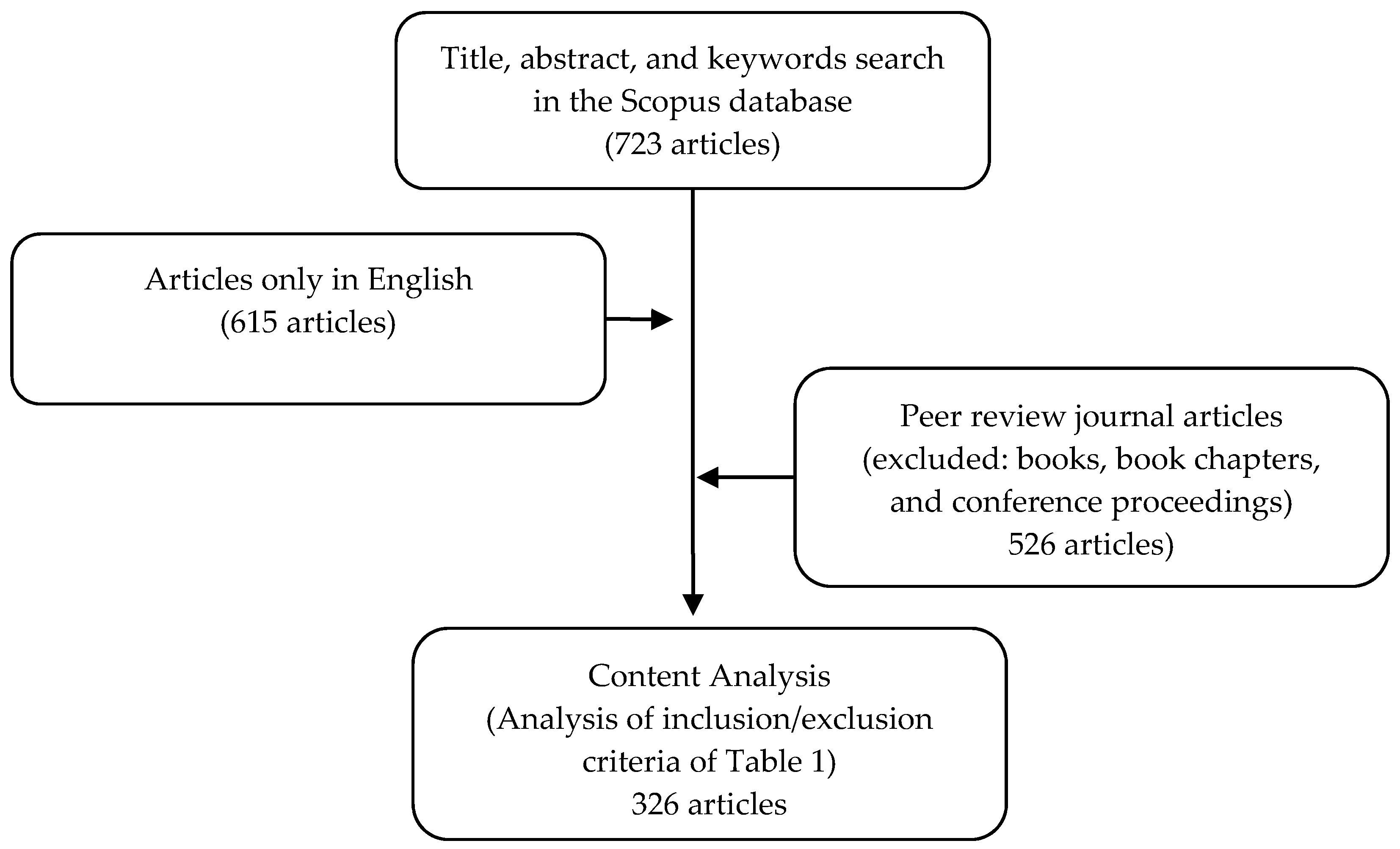

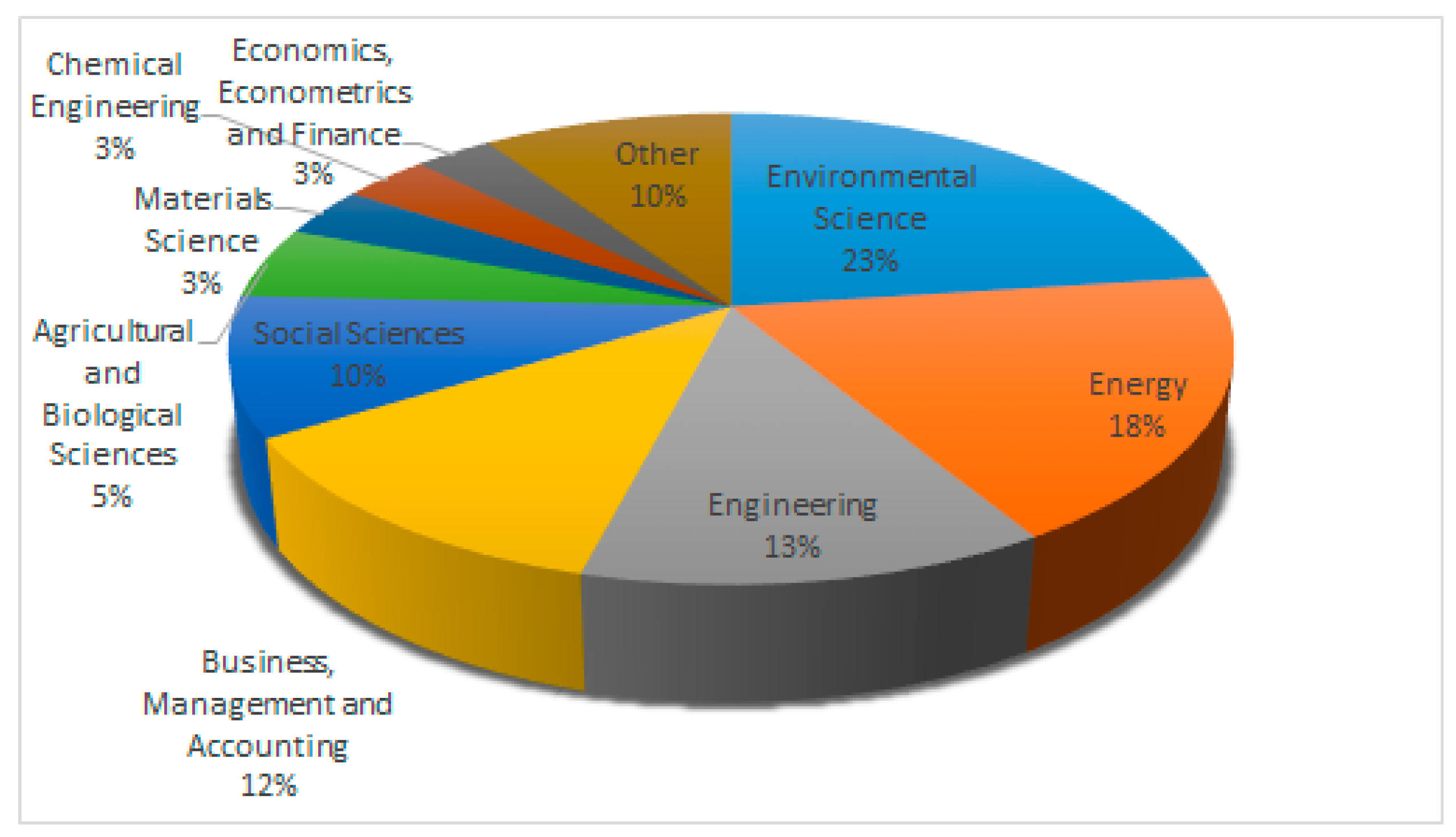
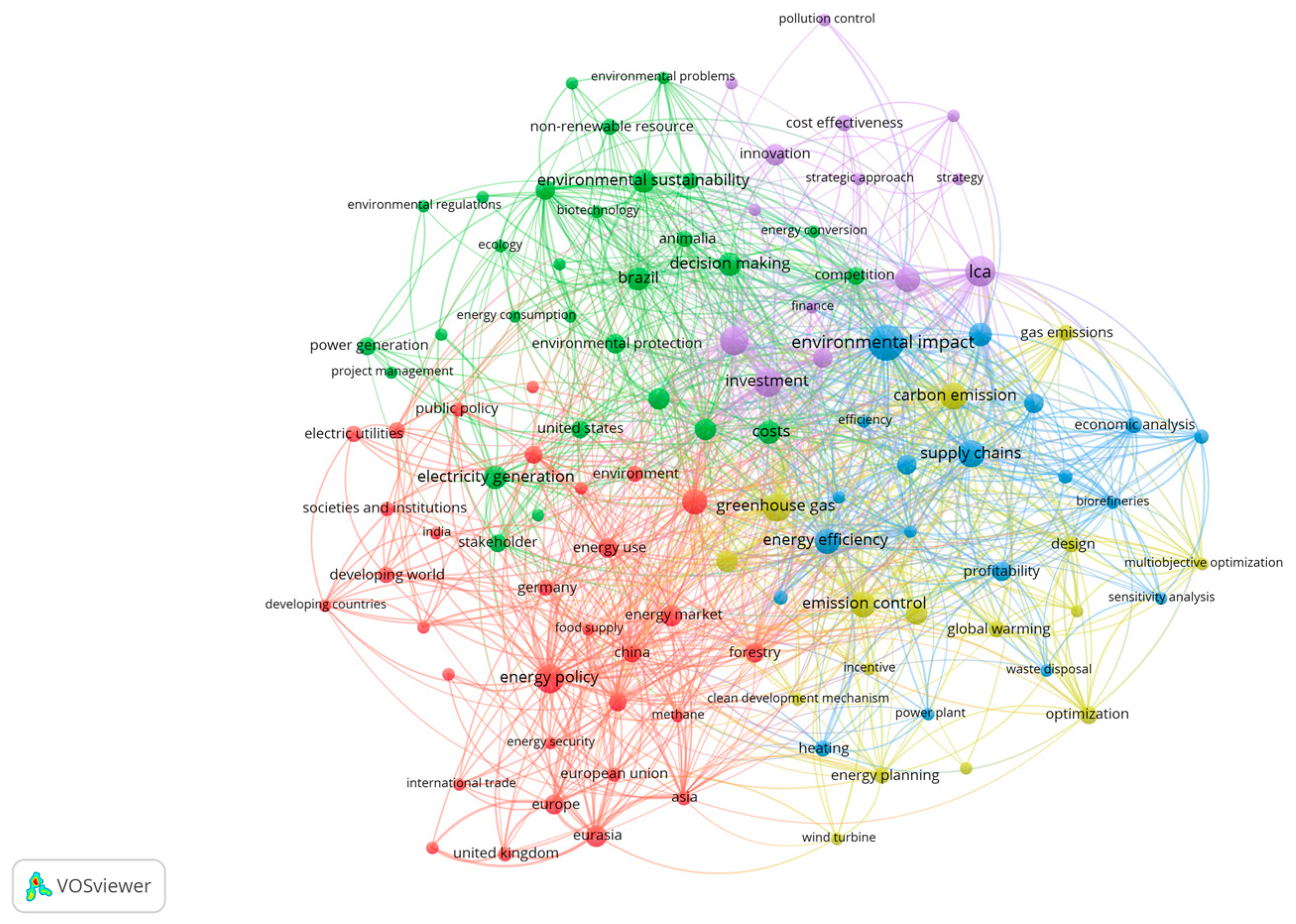
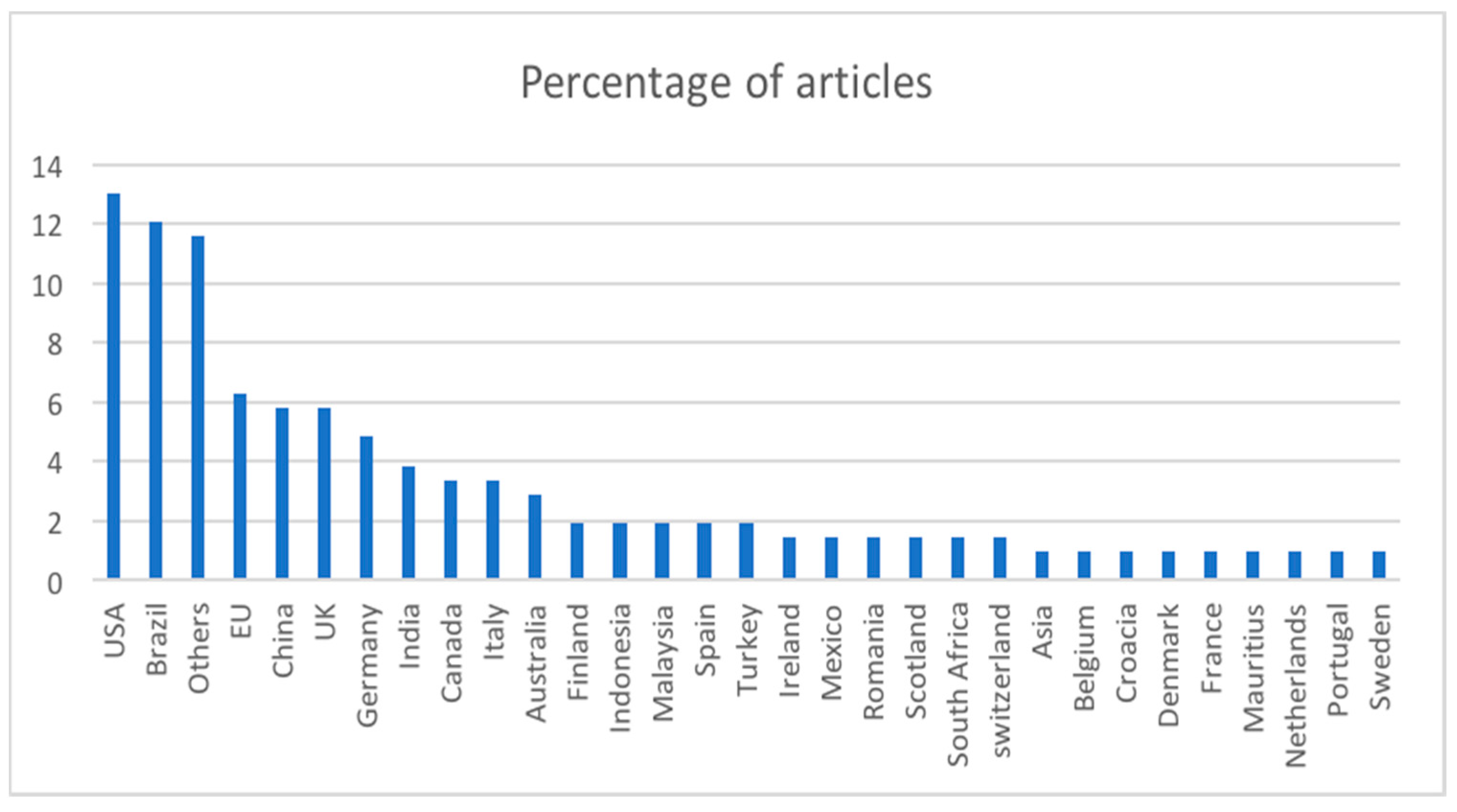
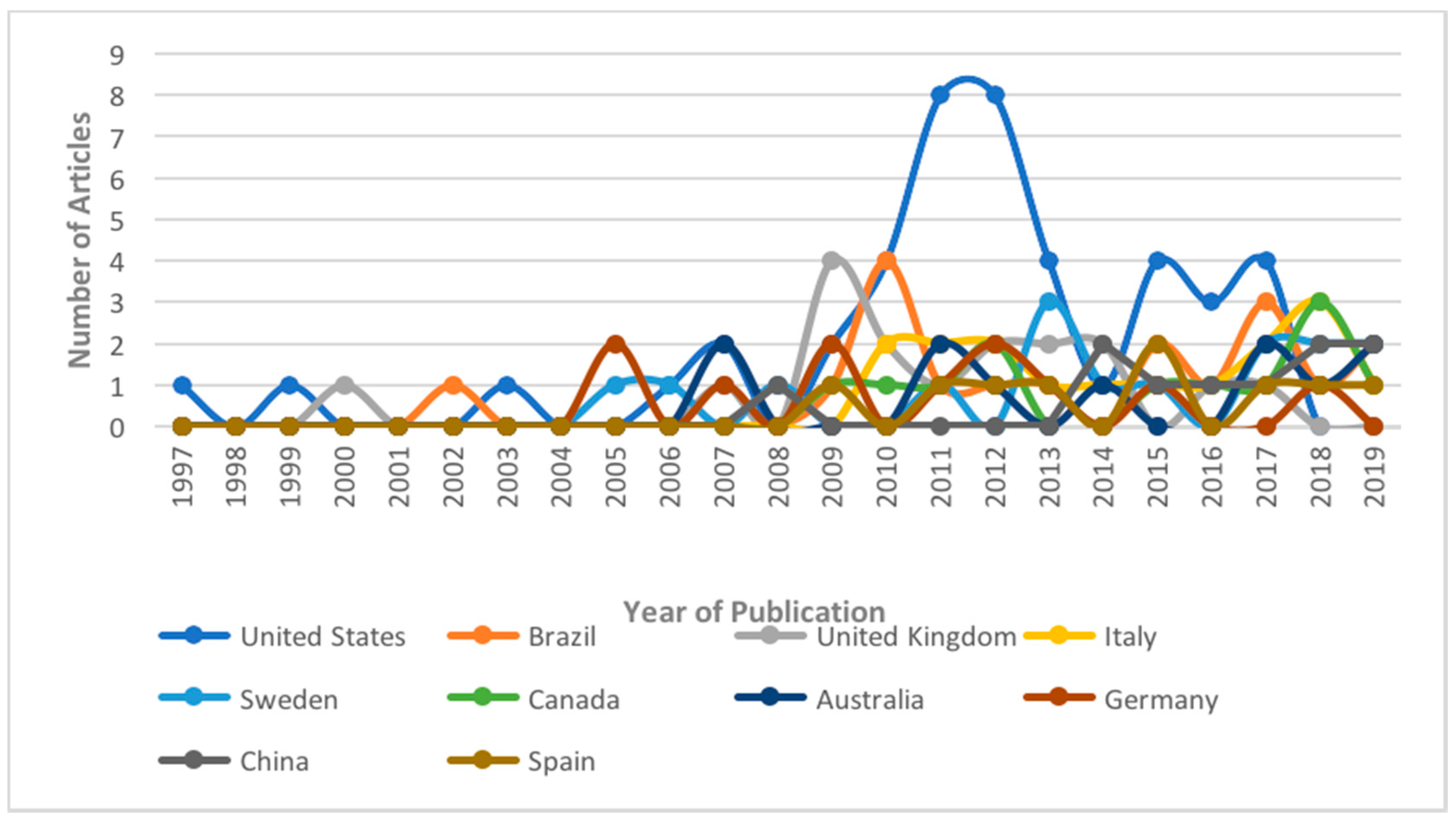
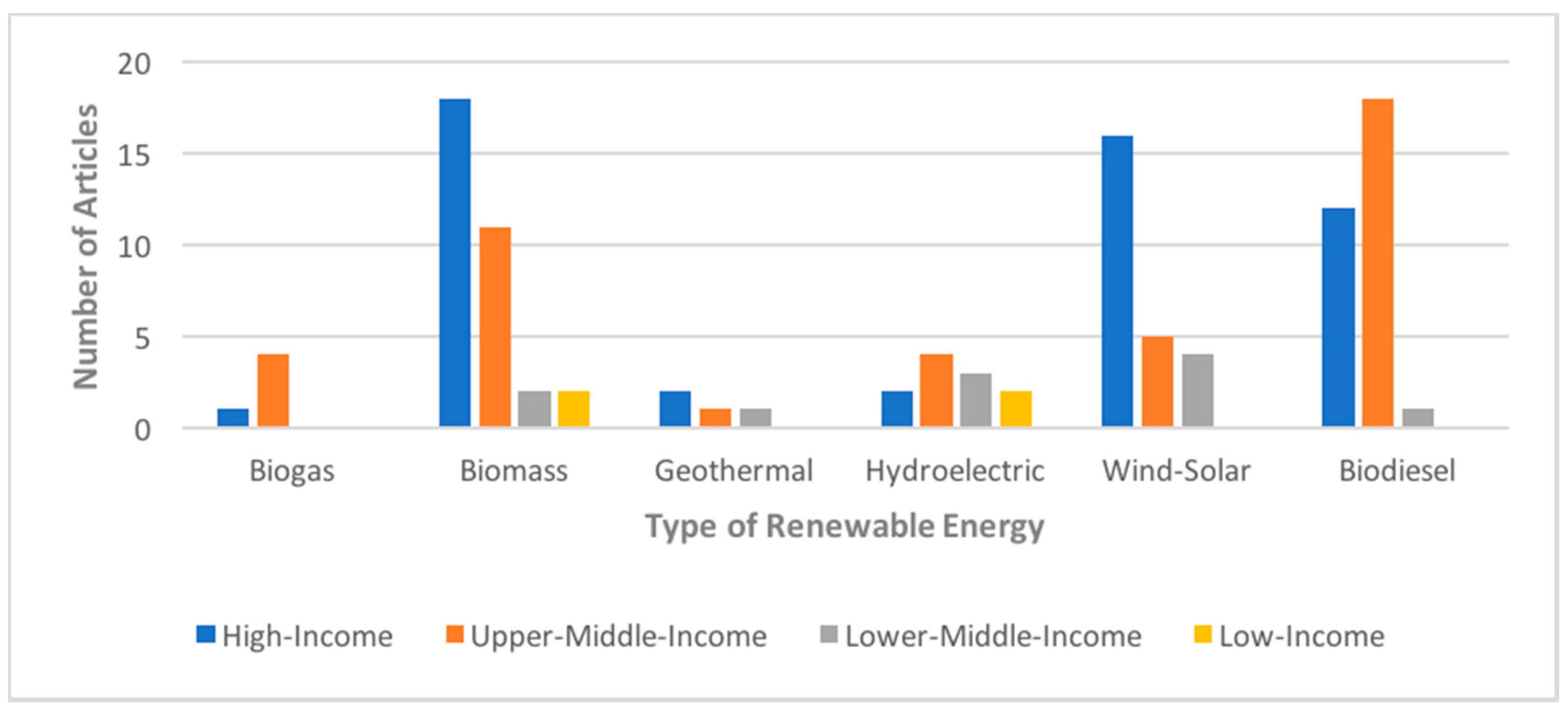

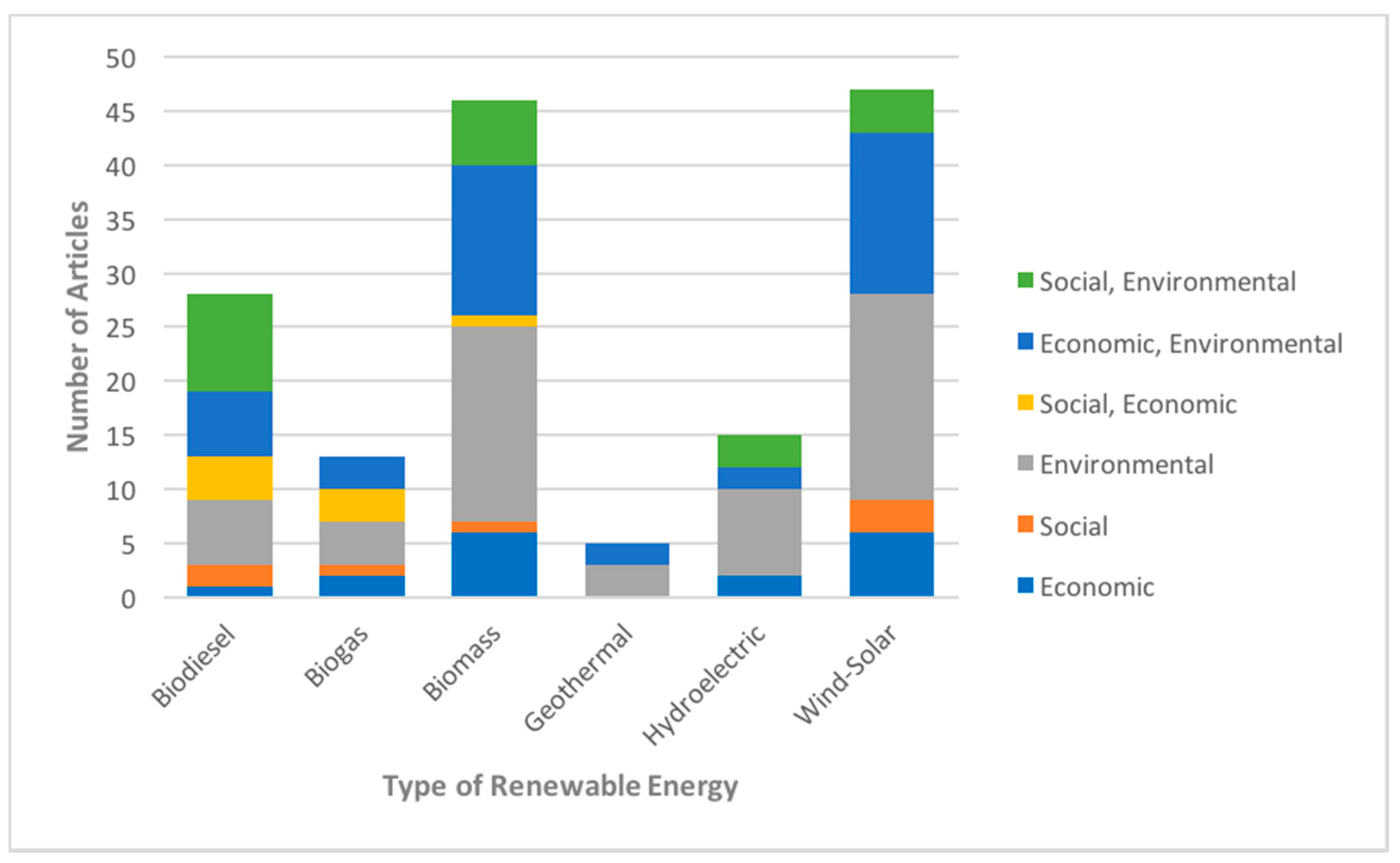
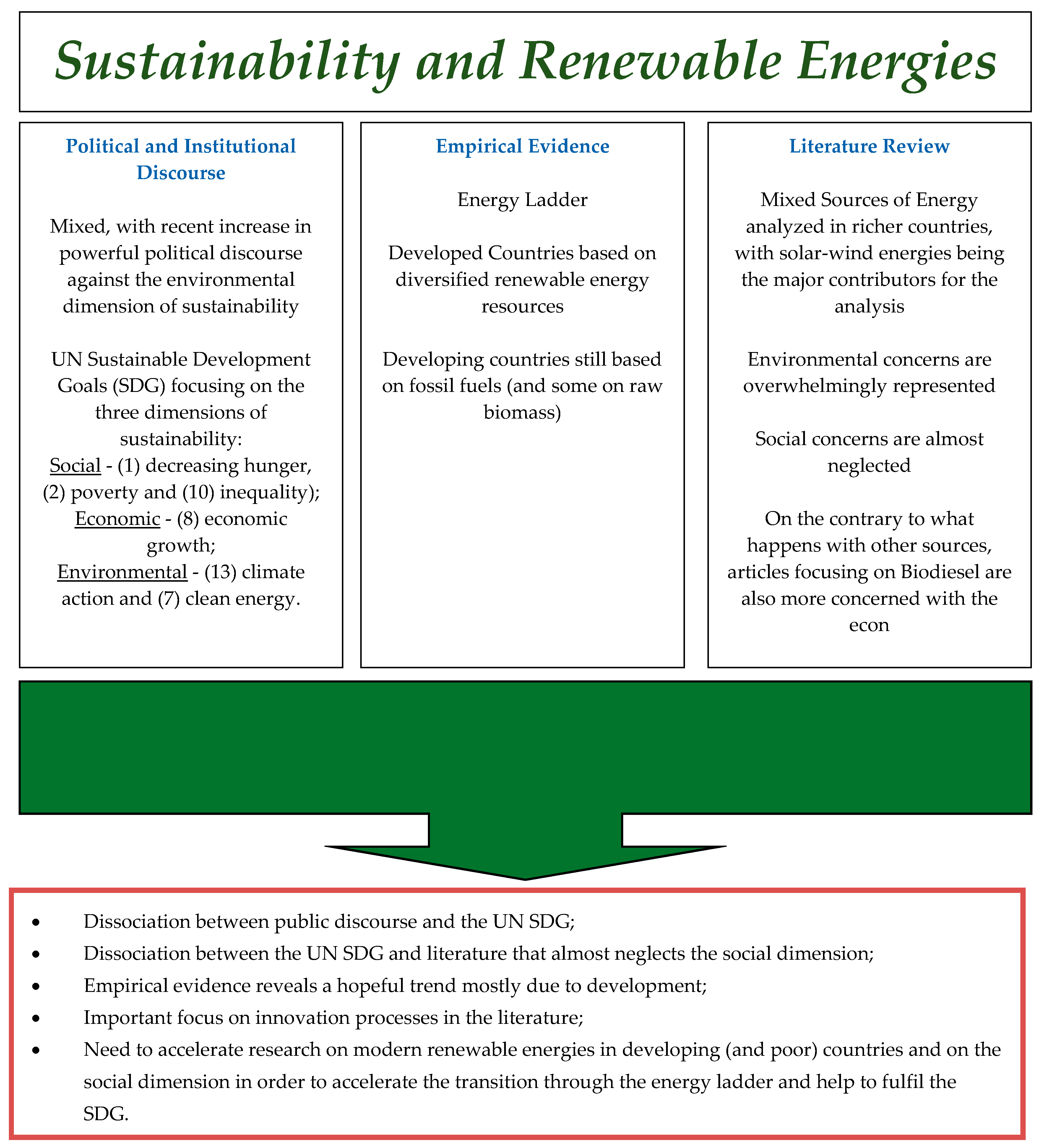
| Inclusion/Exclusion Criteria | Rationale |
|---|---|
| 1. The article must demonstrate that the adoption of renewable energies must be made by the supply side of the economy (namely, but not exclusively, firms) | As the research is not restricted to specific journals, research on units of analysis other than the ones from the supply side may occur, namely adoption by the demand side (e.g., families). |
| 2. The article must focus on at least one dimension of sustainability. | Considering the wide search parameters, some articles may approach sustainability as a secondary issue. |
| 3. The article must focus on both the use of renewable energies and sustainability. | Considering the wide search parameters, some articles may approach potential relationships in hypothetical terms. |
| 4. The article must be based on quantitative or qualitative analysis, or a mixture of both methods | Conceptual articles that do not study a relationship between renewable energies and sustainability are not analyzed |
| Biomass | Biofuel | Solar | Biodiesel | Ethanol | Hydroelectric | |
|---|---|---|---|---|---|---|
| 1997 | ||||||
| 1998 | ||||||
| 1999 | ||||||
| 2000 | ||||||
| 2001 | 1 | |||||
| 2002 | 1 | |||||
| 2003 | ||||||
| 2004 | ||||||
| 2005 | 1 | 1 | ||||
| 2006 | 1 | 1 | ||||
| 2007 | 1 | 1 | 1 | |||
| 2008 | 1 | 1 | ||||
| 2009 | 3 | 1 | 1 | |||
| 2010 | 1 | 3 | 2 | |||
| 2011 | 2 | 2 | 2 | 2 | 1 | |
| 2012 | 1 | 6 | 3 | 2 | 1 | |
| 2013 | 1 | 1 | 3 | 3 | ||
| 2014 | 1 | 1 | 1 | |||
| 2015 | 3 | 1 | 1 | 1 | ||
| 2016 | 1 | 2 | ||||
| 2017 | 3 | 4 | 2 | 3 | 2 | 1 |
| 2018 | 4 | 2 | 1 | 2 | ||
| 2019 | 7 | 4 | ||||
| Total | 25 | 29 | 15 | 9 | 10 | 11 |
© 2020 by the authors. Licensee MDPI, Basel, Switzerland. This article is an open access article distributed under the terms and conditions of the Creative Commons Attribution (CC BY) license (http://creativecommons.org/licenses/by/4.0/).
Share and Cite
Garrido, S.; Sequeira, T.; Santos, M. Renewable Energy and Sustainability from the Supply Side: A Critical Review and Analysis. Appl. Sci. 2020, 10, 5755. https://doi.org/10.3390/app10175755
Garrido S, Sequeira T, Santos M. Renewable Energy and Sustainability from the Supply Side: A Critical Review and Analysis. Applied Sciences. 2020; 10(17):5755. https://doi.org/10.3390/app10175755
Chicago/Turabian StyleGarrido, Susana, Tiago Sequeira, and Marcelo Santos. 2020. "Renewable Energy and Sustainability from the Supply Side: A Critical Review and Analysis" Applied Sciences 10, no. 17: 5755. https://doi.org/10.3390/app10175755
APA StyleGarrido, S., Sequeira, T., & Santos, M. (2020). Renewable Energy and Sustainability from the Supply Side: A Critical Review and Analysis. Applied Sciences, 10(17), 5755. https://doi.org/10.3390/app10175755






